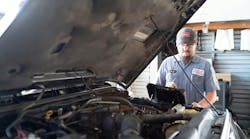If you haven’t investigated repair concerns for electric hybrids and other alternative fuels, the clock is ticking. The market for alternative fuels remains small, but many shops have noticed that traditional maintenance and repair jobs are not increasing while the nation’s passenger vehicle fleet is adopting new technologies. Alternative fuel vehicles are growing and repair shops will be realizing they cannot afford to ignore this market.
Yesterday, VehicleServicePros reported that global production of electric vehicles and plug-in hybrids are expected to rise 67 percent this year, according to IHS Automotive, the research firm. More than 403,000 electrified vehicles are expected to be built in 2014, up from 242,000 in 2013.
Whether or not you believe the market for alternative fuel vehicles is “authentic” (driven by a real customer demand), carmakers are making more of them. So if you’re skeptical about the “authenticity” of this market, ask yourself why more new models are being introduced.
I don’t claim to read minds, but carmakers seem to have found reasons to produce cars with alternative fuels. One reason is that by producing these cars, carmakers are able to meet Corporate Average Fuel Economy (CAFE) fuel economy rules, which the EPA requires. By making plug-in electric vehicles, fuel cell vehicles and compressed natural gas for model years 2017 to 2021, carmakers gain some of the CAFE credits they need, according to the Center for Climate and Energy Solutions. This enables carmakers to meet fuel economy requirements and at the same time keep making the gasoline-powered vehicles that most consumers want to buy.
A similar rationale was noted during the recent Mobile Air Conditioning Society (MACS) training event and trade show in New Orleans about the new R-1234yf refrigerant, which also allows automakers to meet government fuel economy rules. During the MACS State of the Industry Report, a Chrysler representative said CAFE credits is one reason carmakers are moving forward with the new refrigerant.
Speaking of R-1234yf refrigerant, this is another area that shops cannot afford to put off for too long. Many attendees at the MACS show were surprised to learn that nine vehicle models are or will be using the R-1234yf refrigerant this year. The aftermarket will have a “warranty window” with the new refrigerant, but in the not too distant future, shops will need to gear up with the necessary A/C equipment.
Shops will be seeing more vehicles with R-1234yf refrigerant and more vehicles running on alternative energy in the coming years. Those shops that want to maximize their sales opportunities need to invest in the equipment and training required to service future vehicles.


